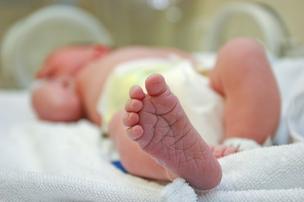 In the organic realm, infant mortality is an important observed phenomenon, with an elevated infant mortality rate being observed in a wide range of species. The study of elevated infant mortality from an evolutionary perspective is part of what is known as Life history theory.
In the organic realm, infant mortality is an important observed phenomenon, with an elevated infant mortality rate being observed in a wide range of species. The study of elevated infant mortality from an evolutionary perspective is part of what is known as Life history theory.Several factors account for elevated infant mortality - for example:
- The small size of infants makes them less able to store resources - and thus more vulnerable to resource fluctuations.
- Some infants are widely dispersed but face patchy environments - where not all of them can thrive.
- Infants are often produced in huge numbers - and there aren't enough resources available for them all to survive to adulthood.
In the 1930s, Ronald Fisher proposed a general concept that covers many of these ideas - known as reproductive value. Reproductive value varies over the lifespan of an organism, reflecting their future reproductive potential. Old organisms have low reproductive value (their expected lifespan is lower and their fertility is reduced) and often infants do as well - due to the kinds of factors mentioned above. Fisher proposed that mortality rates could reasonably be expected to be optimised by natural selection to be proportional to the inverse of reproductive value.
Reproductive value is a concept which is closely related to fitness. Like fitness is is quite a general concept. However, as with fitness it is worth distinguishing between actual reproductive value (measured after the fact) and expected reproductive value - which is calculated on the basis of some other predictive theory about how inherited traits and the environment combine to affect the performance of the organism.
Though the concept of reproductive value is very general it is also often vague. For example, it follows that if infants are produced in huge numbers in each generation they will outstrip their resources, their reproductive value will be low - and there will be high levels of infant mortality. However here, high infant mortality follows directly from high birth rates - and invoking the concept of reproductive value didn't really help very much. It also doesn't help to answer the question of why so many offspring are produced in the first place. Isn't mass infant death very wasteful? In the case of widely dispersed seeds facing a patchy environment, some waste seems inevitable. However, in other cases, natural selection between the offspring may play an important role - weeding out those organisms with deleterious mutations or bad gene combinations by making sure that they "fail fast".
This brings us to cultural infant mortality. Culture provides a new domain for life history theorists with many interesting examples. What can be learned? What can life history theory contribute?
First there are some similarities. As with DNA genes, some memes face a patchy environment. Most flyers are trampled into the ground; the street preacher's ranting mostly gets no further than the sidewalk - and so on. Memes are also mass produced in far greater numbers than can ever survive. Radio and TV signals are broadcast in all directions. Some make it into space, where they could survive for a long time, while most others quickly hit dirt and turn into heat. Start-up companies and IT projects also exhibit high rates of infant mortality.
Also as with genes, many memes are end-of-line copies - with a limited lifespan and a low chance of personal reproduction. Most artifacts are like this. They are the equivalent of somatic cells of cultural evolution - their primary purpose is to assist the reproductive memes in the factory that made them - via cultural kin selection. Life history theory treats these end-of-line copies a bit different from germ-line copies.
Unlike DNA genes, the memes in artifacts often don't have very flexible control over their associated life history variables. If your main strategy for persisting is to be hard and strong that doesn't result in very much flexibility regarding senescence rates. DNA has mastered regeneration - and can more flexibly allocate resources to maintenance processes over the course of a lifespan. Artifact regeneration is a thing - as some automobile owners can attest. However, many artifacts are hard for end users to repair and they often get trashed at the end of their natural lifespan.
Another thing that most memes are not very good at yet is growth. Without growth, infants are not small, and so suffer less from predation and mechanical insults. Of course, some cultural forms do grow. Cities, roads networks and telecommunication networks all grow. However, most artifacts don't really grow - and without growth there is much less scope for infant mortality. Many memes aren't good at growing today. However we are still near to the origin of cultural evolution and it seems reasonable to expect that this limitation will disappear once we have easy access to robust molecular manufacturing technology.
High infant mortality is often regarded as a bad thing. However from the perspective of Darwinian processes, high infant mortality has some desirable aspects. If something is going to fail it is often best if it fails fast. Investments in components that are going to fail are often bad investments: it is better to spend the resources on something that is not going to fail. For many long-lived organisms there's a high-intensity selection process around the time of conception: gamete selection. More failures can occur during gestation and around birth. Rather than lamenting these failures, Darwinism suggests that we should regard them more as part of a natural process of weeding out the weak and unfit before they can do more serious damage to a family's resources.
 Computer programmers have a proverb that goes:
Computer programmers have a proverb that goes: Steven Pinker concluded his
Steven Pinker concluded his 








